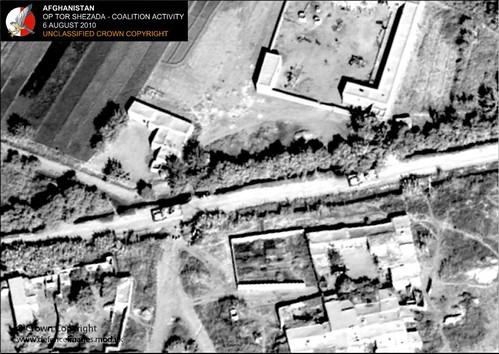Tornado GR 4 RAPTOR Imagery taken from Op TOR SHEZADA
Image by Defence Images
Imagery taken by a Raptor reconnaisance pod attached to a GR4 Tornado aircraft during operations in Afghanistan, showing coalition vehicles manoeuvring.
Reconnaissance Airborne Pod for Tornado, RAPTOR, which is built by BF Goodrich Aerospace, is a new stand-off electro-optical and infrared (IR), long-range oblique-photography pod fitted to the Tornado GR4.
The images received by the pod can be transmitted via a real-time data-link system to image analysts at a ground station, or can be displayed in the cockpit during flight. The imagery can also be recorded for post-flight analysis. The RAPTOR system can create images of hundreds of separate targets in one sortie; it is capable of autonomous operation against preplanned targets, or it can be re-tasked manually for targets of opportunity or to select a different route to the target.
The stand-off range of the sensors allows the aircraft to remain outside heavily-defended areas, to minimise the aircraft’s exposure to enemy air-defence systems.
This image is available for non-commercial, high resolution download at www.defenceimages.mod.uk subject to terms and conditions. Search for image number 45151698.jpg
—————————————————————————-
Photographer: 20100807_OP_TOR_SHEZADA_CF_PATROL_EN2_U_TIW
Image 45151698.jpg from www.defenceimages.mod.uk
Die Casting Aluminum products are of great use in various industry sectors and more so in the aerospace industry where precision and high quality products is of utmost importance. These products are used in building both small as well as the major components in the aviation industry. Further, Aluminum Die Casting parts are used both in the commercial as well as pivotal military sector (in fighter planes etc). The reason for this is simple – they are cost-effective solutions and offer great results.
Apart from being cost effective, the components made from die casting aluminum are additionally prepared to endure harsh weather conditions and increased damages. Another most important reason for using aluminum products in aircrafts is that the metal is comparatively cheaper than other metals that are die-casted. Moreover, aluminum has the potential to gel with other metals in order to offer durability and much flexible.
With aluminum die casted products, you do not have to compromise on the quality yet can them at much cheaper production cost. In addition, all the standards that have been set for using of metal components, aluminum satisfy the need to the utmost. Hence, they are certified safe for use in planes, cost effective and have all the qualities that are required for flying crafts, so Die Casting Aluminum is on the rise like never before. In addition, the best thing about an aluminum die cast part is that its weight is favorable for the aircraft operations.
So, how exactly is Die Casting Aluminum done and what are the processes involved? Well, the answer is simple. Aluminum alloy is first forced into a high-grade steel tool at high speed and pressure in a high temperature. This results in superior quality products that are extremely light and thin walled ideal for use as aircrafts components.
It is to be mentioned here that Aluminum Die Casting is a complex method. Only a really experienced and high skilled team of engineers can ensure that the components come with high volumes or with better tolerances and surface finish. In fact, this type of pressure die-casting is far more popular than gravity die-casting or sand casting. This is because the need for machining in this method whether for aluminum or Zinc Die Casting is very low due to the close casting tolerances. Though the tooling costs in Die Casting Aluminum or rather any metal are considerably higher than the other two methods yet, the mechanical properties achieved thus are far better in terms of functionality.
Alyna Watson is Female and author for a variety of subjects like Die Casting, waterjet, Die Casting Aluminum, PCB Manufacturing, Zinc Die Casting, and other business equipments etc.
Die Casting Aluminum and Its Significance in Aerospace Industry
Nessun commento:
Posta un commento